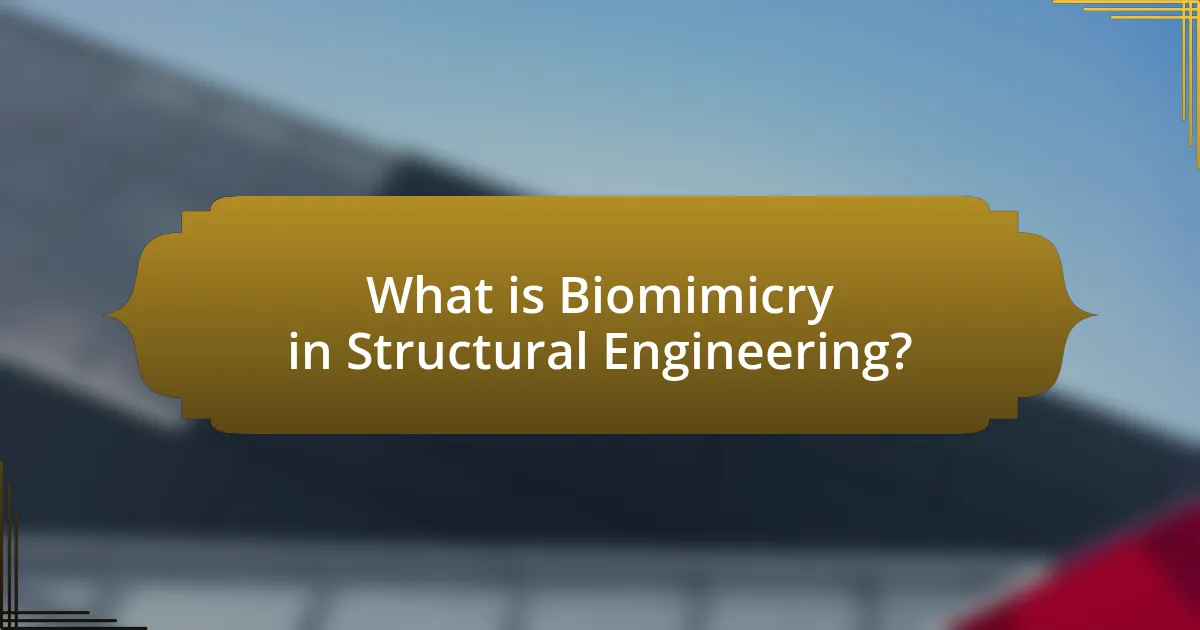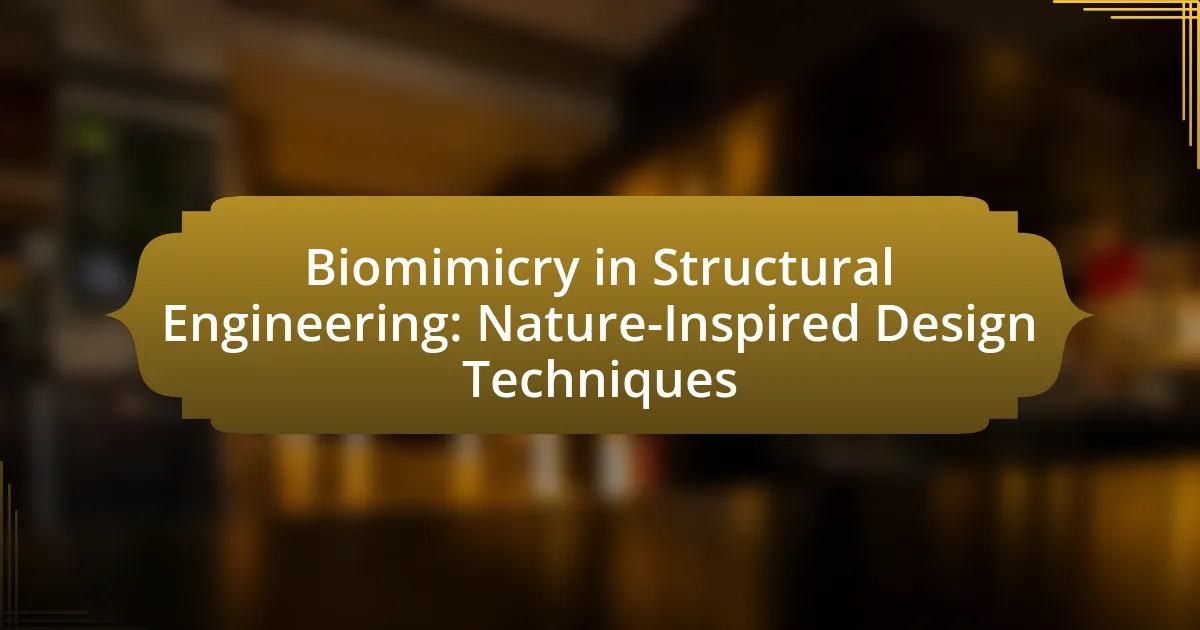Biomimicry in structural engineering refers to the practice of designing structures and materials inspired by natural forms, processes, and ecosystems to enhance efficiency and sustainability. The article explores how this approach influences design techniques, emphasizing key principles such as emulating nature’s strategies to solve human challenges. It highlights various applications of biomimicry, including energy-efficient buildings and innovative materials, while addressing environmental challenges and the importance of interdisciplinary collaboration. Additionally, the article discusses the metrics used to evaluate the effectiveness of biomimetic designs and best practices for engineers in applying these nature-inspired techniques.

What is Biomimicry in Structural Engineering?
Biomimicry in structural engineering is the practice of designing structures and materials inspired by natural forms, processes, and ecosystems. This approach leverages the efficiency and sustainability found in nature, such as the way termite mounds regulate temperature or how spider silk exhibits high tensile strength. By studying these natural phenomena, engineers can create innovative solutions that enhance performance, reduce resource consumption, and minimize environmental impact. For instance, the Eden Project in the UK utilizes biomimetic principles to optimize energy efficiency and maintain a stable internal climate, demonstrating the practical application of nature-inspired design in modern engineering.
How does Biomimicry influence design techniques in structural engineering?
Biomimicry significantly influences design techniques in structural engineering by providing innovative solutions inspired by natural systems and organisms. Engineers study the structural efficiency of natural forms, such as the lightweight yet strong design of bird bones or the self-healing properties of certain plants, to create materials and structures that optimize performance and sustainability. For instance, the Eden Project in the UK utilizes geodesic dome structures inspired by natural forms, which enhance energy efficiency and reduce material usage. This approach not only leads to more resilient and adaptable designs but also promotes environmentally friendly practices, aligning with the principles of sustainable development in engineering.
What are the key principles of biomimicry in engineering?
The key principles of biomimicry in engineering include emulating nature’s designs, processes, and systems to solve human challenges. This approach focuses on sustainability, efficiency, and resilience by studying biological entities and their adaptations. For instance, the design of Velcro was inspired by the way burrs attach to animal fur, demonstrating how natural mechanisms can inform innovative engineering solutions. Additionally, the principle of using local materials and energy sources reflects nature’s optimization strategies, which enhance environmental compatibility and reduce resource consumption. These principles are validated by numerous successful applications in various engineering fields, showcasing the effectiveness of nature-inspired design techniques.
How does nature inspire innovative structural solutions?
Nature inspires innovative structural solutions through biomimicry, where engineers and architects study natural forms and processes to develop efficient designs. For example, the structure of termite mounds has influenced the design of energy-efficient buildings by utilizing natural ventilation systems that regulate temperature without mechanical systems. Additionally, the study of spider silk has led to advancements in materials science, resulting in stronger and lighter materials for construction. These nature-inspired solutions not only enhance sustainability but also improve the performance and resilience of structures, demonstrating the effectiveness of integrating biological principles into engineering practices.
Why is Biomimicry important in modern engineering?
Biomimicry is important in modern engineering because it enables the development of innovative solutions by emulating nature’s time-tested patterns and strategies. This approach leads to more efficient, sustainable, and resilient designs, as seen in structures inspired by natural forms, such as the Eastgate Centre in Zimbabwe, which mimics termite mounds for natural ventilation, reducing energy consumption by 90%. By studying biological systems, engineers can create materials and structures that are not only functional but also environmentally friendly, addressing contemporary challenges like climate change and resource scarcity.
What environmental challenges does biomimicry address?
Biomimicry addresses several environmental challenges, including resource depletion, waste management, and energy efficiency. By emulating nature’s strategies, biomimicry promotes sustainable practices that reduce the consumption of natural resources, as seen in designs inspired by termite mounds for natural cooling, which significantly lowers energy use in buildings. Additionally, biomimetic approaches can enhance waste management by mimicking natural processes that recycle materials, such as the way ecosystems break down organic matter. These strategies not only mitigate environmental impact but also foster innovation in structural engineering, leading to more resilient and sustainable designs.
How does biomimicry contribute to sustainability in construction?
Biomimicry contributes to sustainability in construction by enabling the design of buildings and materials that emulate natural processes and systems, leading to reduced resource consumption and waste. For instance, structures inspired by termite mounds can naturally regulate temperature, minimizing energy use for heating and cooling. Additionally, materials modeled after spider silk exhibit high strength-to-weight ratios, allowing for lighter structures that require less material. Research indicates that implementing biomimetic principles can lead to a 30% reduction in energy consumption and a significant decrease in carbon emissions during construction, demonstrating the effectiveness of this approach in promoting sustainable practices.

What are the applications of Biomimicry in Structural Engineering?
Biomimicry in structural engineering involves applying nature-inspired design techniques to enhance building performance and sustainability. One prominent application is the use of termite mound structures to inform natural ventilation systems, which can significantly reduce energy consumption for heating and cooling. Additionally, the study of spider silk has led to the development of lightweight, high-strength materials that improve structural integrity while minimizing resource use. Research has shown that these biomimetic approaches can lead to more efficient designs, as seen in the Eden Project in the UK, where geodesic domes mimic natural forms to optimize space and energy efficiency.
How are natural forms and processes applied in structural designs?
Natural forms and processes are applied in structural designs through biomimicry, which involves emulating nature’s strategies to solve human engineering challenges. For instance, the design of the Eden Project in the UK utilizes geodesic domes inspired by the structure of carbon molecules, optimizing strength while minimizing material use. Additionally, the Eastgate Centre in Zimbabwe mimics termite mounds to regulate temperature naturally, reducing energy consumption by up to 90% compared to conventional buildings. These examples demonstrate how observing and integrating natural systems can lead to innovative, efficient, and sustainable architectural solutions.
What examples exist of biomimetic structures in architecture?
Biomimetic structures in architecture include the Eden Project in the UK, which mimics the structure of a geodesic dome found in nature, and the Eastgate Centre in Zimbabwe, designed to emulate termite mounds for natural ventilation. The Eden Project utilizes hexagonal patterns to optimize space and energy efficiency, while the Eastgate Centre’s design allows for temperature regulation without conventional air conditioning, showcasing the effectiveness of nature-inspired solutions in sustainable architecture.
How do these applications improve structural performance?
Biomimicry applications improve structural performance by emulating natural systems and processes that have evolved to optimize strength, efficiency, and resilience. For instance, structures inspired by the geometric patterns of honeycombs exhibit enhanced load distribution and material efficiency, leading to lighter yet stronger constructions. Research has shown that buildings designed with biomimetic principles can reduce material usage by up to 30% while maintaining structural integrity, as evidenced by the work of the Biomimicry Institute. Additionally, nature-inspired designs often incorporate adaptive features that respond to environmental changes, improving durability and reducing maintenance costs over time.
What industries are adopting biomimicry in their engineering practices?
The industries adopting biomimicry in their engineering practices include architecture, automotive, aerospace, and materials science. In architecture, firms like Studio Gang utilize natural forms for energy efficiency and structural integrity. The automotive industry, exemplified by companies like BMW, incorporates biomimetic designs for aerodynamics and fuel efficiency. Aerospace companies, such as Boeing, study bird flight patterns to enhance aircraft performance. Additionally, materials science leverages biomimicry to develop innovative materials inspired by natural structures, like spider silk, which is known for its strength and flexibility.
Which sectors benefit most from nature-inspired design techniques?
The sectors that benefit most from nature-inspired design techniques include architecture, engineering, product design, and urban planning. These sectors leverage biomimicry to enhance sustainability, efficiency, and functionality in their projects. For instance, architecture utilizes natural forms and processes to create energy-efficient buildings, while engineering applies principles from biological systems to develop innovative materials and structures. Studies have shown that incorporating nature-inspired designs can lead to significant reductions in energy consumption and resource use, exemplified by the Eden Project in the UK, which mimics natural ecosystems to maintain a stable climate within its biomes.
How is biomimicry reshaping traditional engineering fields?
Biomimicry is reshaping traditional engineering fields by integrating nature-inspired design principles to enhance efficiency and sustainability. Engineers are increasingly studying biological systems to develop innovative solutions, such as using the structure of termite mounds for natural ventilation in buildings, which can reduce energy consumption by up to 30%. This approach not only improves performance but also minimizes environmental impact, as seen in projects like the Eden Project in the UK, where biomimetic designs have led to energy-efficient structures that harmonize with their surroundings.

What challenges exist in implementing Biomimicry in Structural Engineering?
Implementing biomimicry in structural engineering faces several challenges, including the complexity of translating biological principles into engineering applications. Engineers often struggle with understanding the intricate mechanisms of natural systems, which can be difficult to replicate in a built environment. Additionally, there is a lack of standardized methodologies for integrating biomimetic designs into existing engineering practices, leading to inconsistencies in application. Financial constraints also pose a significant barrier, as innovative biomimetic solutions may require higher initial investments compared to traditional methods. Furthermore, regulatory frameworks may not accommodate novel designs inspired by nature, complicating the approval process for new projects. These challenges highlight the need for interdisciplinary collaboration and further research to effectively harness biomimicry in structural engineering.
What are the common obstacles faced by engineers using biomimicry?
Engineers using biomimicry commonly face obstacles such as the complexity of biological systems, the challenge of translating natural designs into practical applications, and the lack of interdisciplinary collaboration. The complexity of biological systems often makes it difficult to fully understand the underlying principles that can be applied to engineering problems. Additionally, translating these intricate natural designs into functional engineering solutions requires advanced modeling and simulation techniques, which may not always be readily available. Furthermore, successful biomimetic projects typically necessitate collaboration across various fields, including biology, engineering, and design, but such interdisciplinary teamwork can be difficult to achieve due to differing terminologies and methodologies.
How can engineers overcome these challenges?
Engineers can overcome challenges in biomimicry by adopting interdisciplinary collaboration, utilizing advanced computational tools, and conducting thorough research on natural systems. Interdisciplinary collaboration allows engineers to integrate insights from biology, materials science, and engineering, leading to innovative design solutions. Advanced computational tools, such as simulation software, enable engineers to model and analyze complex biological structures, facilitating the replication of nature’s efficiencies. Thorough research on natural systems provides engineers with a deeper understanding of biological principles, which can be translated into effective engineering applications. For instance, the study of termite mounds has inspired energy-efficient building designs that regulate temperature naturally, demonstrating the practical benefits of applying biomimicry in structural engineering.
What role does interdisciplinary collaboration play in biomimicry?
Interdisciplinary collaboration is essential in biomimicry as it integrates diverse fields such as biology, engineering, and design to create innovative solutions inspired by nature. This collaboration allows experts to share knowledge and perspectives, leading to more effective and sustainable designs that mimic natural processes. For instance, the development of self-healing materials in structural engineering combines insights from biology and materials science, demonstrating how interdisciplinary efforts can yield practical applications that enhance durability and reduce maintenance costs.
How can the effectiveness of biomimicry be measured in structural projects?
The effectiveness of biomimicry in structural projects can be measured through performance metrics such as energy efficiency, material usage, and structural resilience. These metrics provide quantifiable data that can be compared against traditional design methods. For instance, a study by the University of Cambridge demonstrated that buildings designed with biomimetic principles achieved up to 30% greater energy efficiency compared to conventional designs, highlighting the tangible benefits of nature-inspired techniques. Additionally, evaluating the lifecycle impact of materials used in biomimetic designs can further illustrate their effectiveness, as seen in projects that utilize sustainable materials inspired by natural systems, which often result in reduced environmental footprints.
What metrics are used to evaluate biomimetic designs?
Biomimetic designs are evaluated using metrics such as functionality, efficiency, sustainability, and adaptability. Functionality assesses how well the design meets its intended purpose, while efficiency measures resource use relative to performance. Sustainability evaluates the environmental impact and resource consumption throughout the design’s lifecycle. Adaptability examines the design’s ability to respond to changing conditions or requirements. These metrics are essential for ensuring that biomimetic designs effectively replicate nature’s strategies while addressing human needs.
How do these metrics impact project outcomes?
Metrics in biomimicry impact project outcomes by providing quantifiable measures of design efficiency, sustainability, and performance. These metrics enable engineers to assess how closely a design mimics natural systems, which can lead to innovative solutions that enhance structural integrity and reduce resource consumption. For example, studies have shown that structures designed using biomimetic principles can achieve up to 30% greater energy efficiency compared to traditional designs, as evidenced by the Eden Project in the UK, which utilizes natural ventilation inspired by termite mounds. Thus, the application of these metrics directly correlates with improved project outcomes in terms of sustainability and functionality.
What best practices should engineers follow when applying biomimicry?
Engineers applying biomimicry should prioritize understanding the biological systems they aim to emulate. This involves thorough research into the specific organisms and their adaptations relevant to the engineering challenge. For instance, studying the structure of termite mounds has led to energy-efficient building designs that regulate temperature naturally. Additionally, engineers should collaborate with biologists to ensure accurate interpretation of biological principles, which enhances the effectiveness of the biomimetic solutions. Furthermore, iterative prototyping and testing of designs inspired by nature can lead to innovative solutions that are both functional and sustainable, as demonstrated by the development of Velcro, inspired by burrs.

Leave a Reply